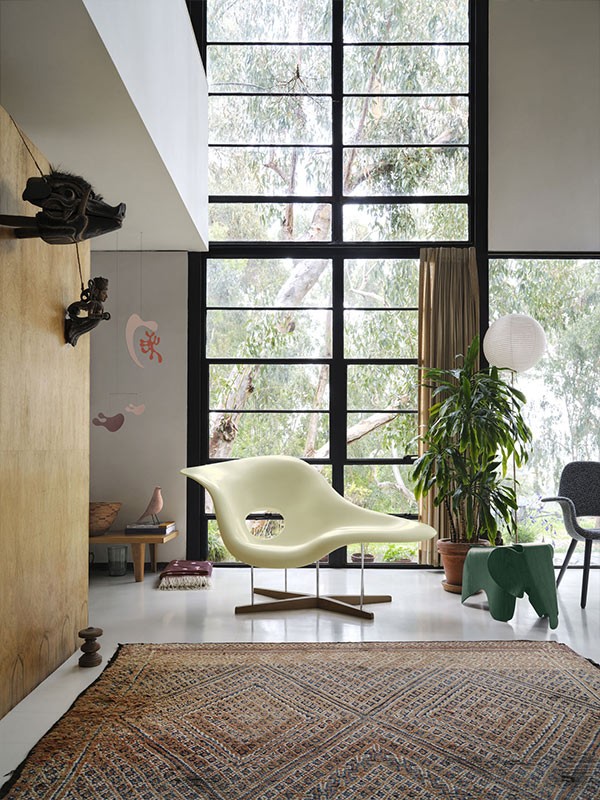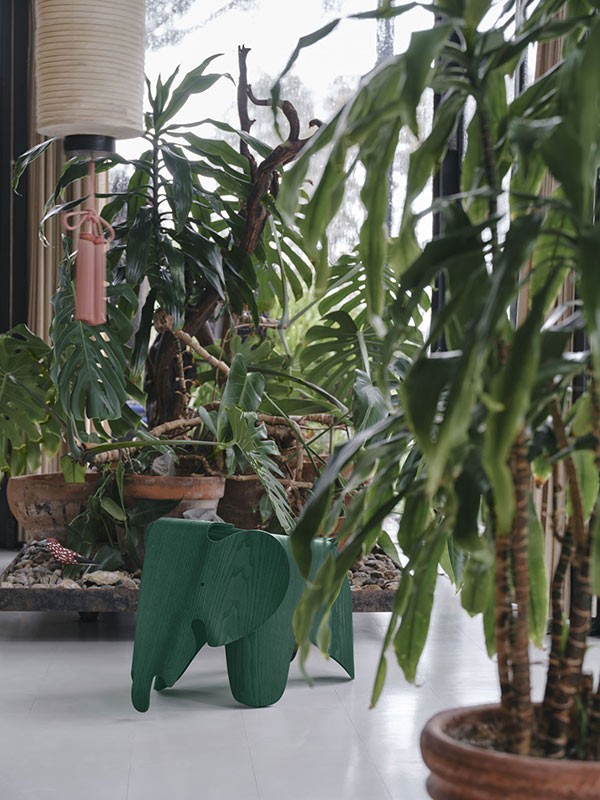
Eames House: A creative legacy
As the Eames House nears its 75th anniversary, we delve into the extraordinary story of Ray and Charles Eames, creative giants of the Twentieth Century, and their iconic architectural masterpiece in Los Angeles.
Ray and Charles Eames were true Twentieth Century creative powerhouses. In addition to their iconic work in the furniture field, they also produced art, films, graphic design and architecture. They were problem solvers, always on a project, and would rarely let their attention divert from their creative pursuits. The Eames House is probably their greatest tribute to this ethic and attitude, with the house taking each strand of their interests and binding them together in one major project.
Standing tall on a steep cliff above the Pacific Ocean in the Pacific Palisades neighbourhood of Los Angeles, the Eames House was designed by the couple in 1949. It was brought to life via a competition in Arts & Architecture Magazine, which also gifted the house with its somewhat unusual name.
Case Study House 8
Formally known as Case Study House 8, the Eames House was one of a series of property concepts envisioned by a study programme that saw several influential and important figures in design conceive of new ways of living following the Second World War. A major part of this challenge was to incorporate the use of new materials and processes developed during the war years to create something that would address the burgeoning housing crisis that affected America at this time. Ardent pacifists Charles and Ray had previously sought to help with the war effort “without hurting anybody”. They worked on humanitarian projects for the military, most famously designing a moulded wooden leg splint that would, in turn, inform and inspire their work with plywood in the furniture field in the decade that followed. Their involvement in the Arts & Architecture Magazine project can be seen as something of an extension of this approach, with the couple seeking to use their design skills to help others and change the world.
What’s particularly interesting about the Eames House is that the designers used mass-production techniques and prefabricated materials to bring everything together. The instantly recognisable collage-like structure sits atop a modular steel frame, with large floor-to-ceiling windows allowing for lots of light to fill the home.
The site itself is formed of two structures, the home space and a studio, which are connected by an outdoor patio. Trees surround the structures; Ray Eames had a deep love for all matters horticultural, meaning that the house was filled with lots of plants, in turn creating a welcoming atmosphere well suited to entertaining for both pleasure and professional purposes. Both structures have two stories. The home was used for entertaining, teaching, and general hosting, while the Wider Eames family of children and grandchildren speak of leisurely summers spent relaxing and playing at the house. The couple would live in the house until their respective deaths, with Charles passing in 1978 and Ray ten years later to the day, in 1988.
Filled with objects both found and designed, Ray and Charles placed their own objects and creations alongside beloved pieces picked up on the road. They lived with the very furniture that they designed, testing them and perfecting them. Folk art produced by Native American artists sits next to Ray’s paintings and sculptures, while gifts from as far away as East Asia and as close as the neighbouring ocean are placed next to one another, creating a collage of storytelling that tells the story of the Eameses life and work. Just as the two buildings sit next to one another, so does the life and work of the pair, with each element, life and work, informing the other wholly.
Rolf Fehlbaum, the former chairman of Vitra and close friend of Ray and Charles, once joked that he could never imagine the couple taking a vacation, such was their commitment to their work. He noted, too, that they never actually stopped working on a product, with constant re-evaluation of material, finish and application being undertaken, with new solutions to emerging problems constantly being troubleshooted. This is an ethos which carries through to the manner in which Vitra continues to develop the iconic products in ambitious and interesting new ways.
The Eames House is now a National Historic Landmark and remains the working base of the Eames office, which is run by their grandchildren of Ray and Charles Eames, the very same grandchildren who spent endless summers at the house while growing up.
Eames Special Collection
To mark the ongoing relationship between Vitra and Eames, the Swiss furniture company have reissued a number of classic Eames designs in fresh colourways. The Eames Bird, which has held court in the centre of the living room of the Eames House for over 70 years, is refreshed with two new editions, one Dark Green and the other Pale Rose, with these versions available for just a couple of months through January 2024. Similarly, a Dark Green take on the popular Eames Elephant, a favourite of design aficionados around the world since 1945, is also available through the same time period. The collection is capped with a very special edition of the iconic Eames Lounge Chair and Ottoman, which is upholstered in a lavish Phlox corduroy fabric and makes for a playful nod back to the experimentation that occurred within the Eames studio when Charles and Ray were designing the chair in the 1950s.
Do you own an Eames icon? Show us your favourite Eames designs through Instagram by tagging us @nest_co_uk.
Images: Vitra and © Eames Office, LLC (eamesoffice.com). All rights reserved.
Eames House: A creative legacy

As the Eames House nears its 75th anniversary, we delve into the extraordinary story of Ray and Charles Eames, creative giants of the Twentieth Century, and their iconic architectural masterpiece in Los Angeles.
Ray and Charles Eames were true Twentieth Century creative powerhouses. In addition to their iconic work in the furniture field, they also produced art, films, graphic design and architecture. They were problem solvers, always on a project, and would rarely let their attention divert from their creative pursuits. The Eames House is probably their greatest tribute to this ethic and attitude, with the house taking each strand of their interests and binding them together in one major project.
Standing tall on a steep cliff above the Pacific Ocean in the Pacific Palisades neighbourhood of Los Angeles, the Eames House was designed by the couple in 1949. It was brought to life via a competition in Arts & Architecture Magazine, which also gifted the house with its somewhat unusual name.
Case Study House 8
Formally known as Case Study House 8, the Eames House was one of a series of property concepts envisioned by a study programme that saw several influential and important figures in design conceive of new ways of living following the Second World War. A major part of this challenge was to incorporate the use of new materials and processes developed during the war years to create something that would address the burgeoning housing crisis that affected America at this time. Ardent pacifists Charles and Ray had previously sought to help with the war effort “without hurting anybody”. They worked on humanitarian projects for the military, most famously designing a moulded wooden leg splint that would, in turn, inform and inspire their work with plywood in the furniture field in the decade that followed. Their involvement in the Arts & Architecture Magazine project can be seen as something of an extension of this approach, with the couple seeking to use their design skills to help others and change the world.
What’s particularly interesting about the Eames House is that the designers used mass-production techniques and prefabricated materials to bring everything together. The instantly recognisable collage-like structure sits atop a modular steel frame, with large floor-to-ceiling windows allowing for lots of light to fill the home.
The site itself is formed of two structures, the home space and a studio, which are connected by an outdoor patio. Trees surround the structures; Ray Eames had a deep love for all matters horticultural, meaning that the house was filled with lots of plants, in turn creating a welcoming atmosphere well suited to entertaining for both pleasure and professional purposes. Both structures have two stories. The home was used for entertaining, teaching, and general hosting, while the Wider Eames family of children and grandchildren speak of leisurely summers spent relaxing and playing at the house. The couple would live in the house until their respective deaths, with Charles passing in 1978 and Ray ten years later to the day, in 1988.
Filled with objects both found and designed, Ray and Charles placed their own objects and creations alongside beloved pieces picked up on the road. They lived with the very furniture that they designed, testing them and perfecting them. Folk art produced by Native American artists sits next to Ray’s paintings and sculptures, while gifts from as far away as East Asia and as close as the neighbouring ocean are placed next to one another, creating a collage of storytelling that tells the story of the Eameses life and work. Just as the two buildings sit next to one another, so does the life and work of the pair, with each element, life and work, informing the other wholly.
Rolf Fehlbaum, the former chairman of Vitra and close friend of Ray and Charles, once joked that he could never imagine the couple taking a vacation, such was their commitment to their work. He noted, too, that they never actually stopped working on a product, with constant re-evaluation of material, finish and application being undertaken, with new solutions to emerging problems constantly being troubleshooted. This is an ethos which carries through to the manner in which Vitra continues to develop the iconic products in ambitious and interesting new ways.
The Eames House is now a National Historic Landmark and remains the working base of the Eames office, which is run by their grandchildren of Ray and Charles Eames, the very same grandchildren who spent endless summers at the house while growing up.
Eames Special Collection
To mark the ongoing relationship between Vitra and Eames, the Swiss furniture company have reissued a number of classic Eames designs in fresh colourways. The Eames Bird, which has held court in the centre of the living room of the Eames House for over 70 years, is refreshed with two new editions, one Dark Green and the other Pale Rose, with these versions available for just a couple of months through January 2024. Similarly, a Dark Green take on the popular Eames Elephant, a favourite of design aficionados around the world since 1945, is also available through the same time period. The collection is capped with a very special edition of the iconic Eames Lounge Chair and Ottoman, which is upholstered in a lavish Phlox corduroy fabric and makes for a playful nod back to the experimentation that occurred within the Eames studio when Charles and Ray were designing the chair in the 1950s.
Do you own an Eames icon? Show us your favourite Eames designs through Instagram by tagging us @nest_co_uk.
Images: Vitra and © Eames Office, LLC (eamesoffice.com). All rights reserved.











